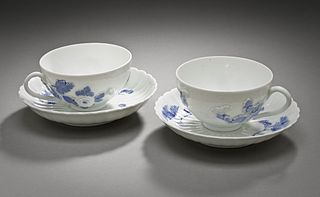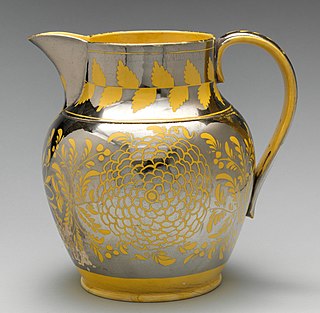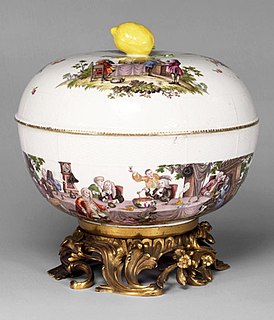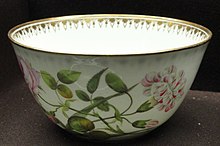Pewter is a malleable metal alloy composed of 85–99% tin, mixed with approximately 5–10% antimony, 2% copper, bismuth, and sometimes silver. Copper and antimony act as hardeners but may be replaced with lead in lower grades of pewter, imparting a bluish tint. Pewter has a low melting point, around 170–230 °C (338–446 °F), depending on the exact mixture of metals. The word pewter is probably a variation of the word spelter, a term for zinc alloys.

A teapot is a vessel used for steeping tea leaves or a herbal mix in boiling or near-boiling water, and for serving the resulting infusion which is called tea. Dry tea is available either in tea bags or as loose tea, in which case a tea infuser or tea strainer may be of some assistance, either to hold the leaves as they steep or to catch the leaves inside the teapot when the tea is poured. Teapots usually have an opening with a lid at their top, where the dry tea and hot water are added, a handle for holding by hand and a spout through which the tea is served. Some teapots have a strainer built-in on the inner edge of the spout. A small air hole in the lid is often created to stop the spout from dripping and splashing when tea is poured. In modern times, a thermally insulating cover called a tea cosy may be used to enhance the steeping process or to prevent the contents of the teapot from cooling too rapidly.

Pottery and porcelain, is one of the oldest Japanese crafts and art forms, dating back to the Neolithic period. Kilns have produced earthenware, pottery, stoneware, glazed pottery, glazed stoneware, porcelain, and blue-and-white ware. Japan has an exceptionally long and successful history of ceramic production. Earthenwares were created as early as the Jōmon period, giving Japan one of the oldest ceramic traditions in the world. Japan is further distinguished by the unusual esteem that ceramics holds within its artistic tradition, owing to the enduring popularity of the tea ceremony.

A teacup is a cup for drinking tea. It may be with or without a handle, generally a small one that may be grasped with the thumb and one or two fingers. It is typically made of a ceramic material. It is usually part of a set, composed of a cup and a matching saucer or a trio that includes a small cake or sandwich plate. These in turn may be part of a tea set in combination with a teapot, cream jug, covered sugar bowl and slop bowl en suite. Teacups are often wider and shorter than coffee cups. Cups for morning tea are conventionally larger than cups for afternoon tea.

Tableware are the dishes or dishware used for setting a table, serving food and dining. It includes cutlery, glassware, serving dishes and other items for practical as well as decorative purposes. The quality, nature, variety and number of objects varies according to culture, religion, number of diners, cuisine and occasion. For example, Middle Eastern, Indian or Polynesian food culture and cuisine sometimes limits tableware to serving dishes, using bread or leaves as individual plates. Cups are not dishes. Special occasions are usually reflected in higher quality tableware.

A bowl is a round dish or container typically used to prepare and serve food. The interior of a bowl is characteristically shaped like a spherical cap, with the edges and the bottom forming a seamless curve. This makes bowls especially suited for holding liquids and loose food, as the contents of the bowl are naturally concentrated in its center by the force of gravity. The exterior of a bowl is most often round but can be of any shape, including rectangular.

Lustreware or Lusterware is a type of pottery or porcelain with a metallic glaze that gives the effect of iridescence. It is produced by metallic oxides in an overglaze finish, which is given a second firing at a lower temperature in a "muffle kiln", or a reduction kiln, excluding oxygen.

Chinese export porcelain includes a wide range of Chinese porcelain that was made (almost) exclusively for export to Europe and later to North America between the 16th and the 20th century. Whether wares made for non-Western markets are covered by the term depends on context. Chinese ceramics made mainly for export go back to the Tang dynasty if not earlier, though initially they may not be regarded as porcelain.

Kraak ware or Kraak porcelain is a type of Chinese export porcelain produced mainly in the late Ming Dynasty, in the Wanli reign (1573–1620), but also in the Tianqi (1620-1627) and the Chongzhen (1627-1644). It was among the first Chinese export wares to arrive in Europe in mass quantities, and was frequently featured in Dutch Golden Age paintings of still life subjects with foreign luxuries.

The Van Tilburg Collection is a permanent museum that comprises 17th and 18th century furniture, paintings, Delft ceramics and other works of art, and includes the largest South African collection of Chinese ceramic objects. The oriental ceramic collection comprises 1699 pieces of earthenware, stoneware and porcelain dating from about 2000 BC until the early twentieth century.

A tea set or tea service is a collection of matching teaware and related utensils used in the preparation and serving of tea. The traditional components of a tea set may vary between societies and cultures.

Chinese ceramics show a continuous development since pre-dynastic times and are one of the most significant forms of Chinese art and ceramics globally. The first pottery was made during the Palaeolithic era. Chinese ceramics range from construction materials such as bricks and tiles, to hand-built pottery vessels fired in bonfires or kilns, to the sophisticated Chinese porcelain wares made for the imperial court and for export. Porcelain was a Chinese invention and is so identified with China that it is still called "china" in everyday English usage.

A chawan is a bowl used for preparing and drinking tea. Many types of chawan are used in East Asian tea ceremonies. The choice of their use depends upon many considerations.

Medici porcelain was the first successful attempt in Europe to make imitations of Chinese porcelain, though it was soft-paste porcelain rather than the hard-paste made in Asia. The experimental manufactory housed in the Casino of San Marco in Florence existed between 1575 and 1587 under the patronage of Francesco I de' Medici, Grand Duke of Tuscany. Surviving examples are extremely rare, and the great majority of the 60-70 examples are in museums.

A punch bowl is a bowl, often large and wide, in which the drink punch is served.

Dehua porcelain, more traditionally known in the West as Blanc de Chine, is a type of white Chinese porcelain, made at Dehua in the Fujian province. It has been produced from the Ming dynasty (1368–1644) to the present day. Large quantities arrived in Europe as Chinese export porcelain in the early 18th century and it was copied at Meissen and elsewhere. It was also exported to Japan in large quantities.

Qingbai ware is a type of Chinese porcelain produced under the Song Dynasty and Yuan dynasty, defined by the ceramic glaze used. Qingbai ware is white with a blue-greenish tint, and is also referred to as Yingqing. It was made in Jiangxi province in south-eastern China, in several locations including Jingdezhen, and is arguably the first type of porcelain to be produced on a very large scale. However, it was not at the time a prestigious ware, and was mostly used for burial wares and exports, or a middle-rank Chinese market. The quality is very variable, reflecting these different markets; the best pieces can be very thin-walled.

Jian ware or Chien ware is a type of Chinese pottery originally made in Jianyang, Fujian province. It, and local imitations of it, is known in Japan as Tenmoku (天目). The ware are simple shapes in stoneware, with a strong emphasis on subtle effects in the glazes. In the Song dynasty they achieved a high prestige, especially among Buddhist monks and in relation to tea-drinking. They were also highly valued in Japan, where many of the best examples were collected. Though the ceramic body is light-coloured, the wares, generally small cups for tea, bowls and vases, normally are glazed in dark colours, with special effects such as the "hare's fur" "oil-spot" and "partridge feather" patterns caused randomly as excess iron in the glaze is forced out during firing.

A toilet service is a set of objects for use at the dressing table. The term is usually reserved for large luxury sets from the 17th to 19th centuries, with "toilet set" used for later or simpler sets. Historically, services were made in metal, ceramics, and other materials, for both men and women, though male versions were generally much smaller. The rich had services in gold, silver, or silver-gilt. The contents vary, but typically include a mirror, one or more small ewers and basins, two candlesticks, and an assortment of bowls, boxes, caskets, and other containers. One or more brushes and a pin-cushion, often as a top to a box, are often included. The sets usually came with a custom-made travelling case, and some services were especially designed for travelling.

The Swan Service is a large service of baroque Meissen porcelain which was made for the First Minister of the Electorate of Saxony and favourite of Augustus III of Poland, Heinrich von Brühl. Augustus III had made Brühl the Supervisor of the Meissen works in 1733, then in August 1739 its Director. The Swan Service has been called "the most famous high baroque production in Meissen porcelain", "a triumph of modelling and firing", and "the most fabulous tableware conceived in porcelain". After earlier work with prototypes, the Meissen designers and modellers Johann Joachim Kändler, Johann Friedrich Eberlein and Johann Gottlieb Ehder created the service, which consists of over 2,200 individual pieces, between 1737 and 1741 or 1742.























